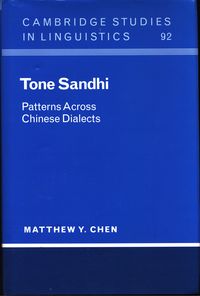| INDICE: |
| XI | | Preface |
| XVII | | Notational conventions |
| 1 | 1 | Setting the stage |
| 1 | 1 | Languages and dialects of China |
| 4 | 2 | Historical background |
| 13 | 3 | Tone Patterns in prresent day dialects |
| 19 | 4 | Tones in context |
| 38 | 5 | Synchronic relevance of diachrony |
| 49 | 6 | Citation tone, base tone, sandhi tone |
| 53 | 2 | Tonal representation and tonal processes |
| 53 | 1 | Tonal representation |
| 57 | 2 | The autosegmental status of tone |
| 63 | 3 | Tonal geometry and the typology of spread/shift rules |
| 79 | 4 | Dissimilation and substitution |
| 84 | 5 | Neutralization and differentiation |
| 96 | | Appendix: Tone features |
| 98 | 3 | Directionality and interacting sandhi processes I |
| 98 | 1 | The nature of the problem |
| 105 | 2 | Tianjin: directionality effect |
| 110 | 3 | A derivational account |
| 118 | 4 | Contraints on derivaation? |
| 122 | 5 | A non-derivational alternative |
| 134 | 6 | Cross-level contraints |
| 140 | 7 | Harmonic serialism |
| 147 | 8 | Concluding remarks |
| 150 | 4 | Directionality and interacting sandhi processes II |
| 150 | 1 | Changting: preamble |
| 153 | 2 | Temporal Sequence and No-Backtracking |
| 158 | 3 | Temporal sequencing vs. sttructural affiinity |
| 165 | 4 | Derivational economy and structural complexity |
| 172 | 5 | Concluding remarks |
| 174 | 5 | rom base tones to sandhi forms: a contraint-based |
| 176 | 1 | Background |
| 179 | 2 | Parallel contraint satisfaction |
| 186 | 3 | Contraint ranking |
| 201 | 4 | Opacity |
| 209 | 5 | Competing strategies |
| 218 | | Appendix: Sandhi forms of disyllabic compounds (New Chongming dialect) |
| 219 | 6 | From tone to accent |
| 220 | 1 | Shanghai: an aborted accentual system? |
| 225 | 2 | New Chongming: an emrgent accentual system? |
| 232 | 3 | Culminative accent |
| 244 | 4 | Saliency and Edgemostness |
| 253 | 5 | Prosodic weight and recursive contraint satisfaction |
| 267 | 6 | Tonic clash |
| 277 | 7 | Semantically determined prominence |
| 280 | 8 | Levelling |
| 285 | 7 | Stress-foot as sandhi domain I |
| 286 | 1 | The phonological status of stress in Chinese |
| 295 | 2 | Stress-sensitive tonal phenomena |
| 306 | 3 | Shanghai: stress-foot as sandhi domain |
| 320 | 8 | Stress-foot as sandhi domain II |
| 320 | 1 | Wuxi: stress shift |
| 325 | 2 | Danyang: asymmetric stress clash |
| 341 | 3 | Nantong: stress-foot and p-word |
| 364 | 9 | Minimal rhythmic unit as obligatory sandhi domain |
| 366 | 1 | Minimal rhythmic units |
| 380 | 2 | A two-pass MRU formation |
| 386 | 3 | The syntactic word |
| 396 | 4 | The phonological word |
| 403 | 5 | Summary |
| 404 | 6 | he prosodic hierarchy |
| 414 | 7 | Syntactic juncture |
| 417 | 8 | Meaning-based prosodic structure |
| 426 | | Appendix: Prosodic and syntactic word |
| 431 | 10 | Phonological phrase as sandhi domain |
| 431 | 1 | End-based p-phrase |
| 441 | 2 | Supporting evidence for p-phrase |
| 446 | 3 | M-command or domain c-command |
| 455 | 4 | Lexical government |
| 471 | 5 | Rhythmic effect in Xiamen |
| 475 | 11 | From tone to intonation |
| 476 | 1 | Wenzhou tone system |
| 477 | 2 | Word-level tone sandhi |
| 486 | 3 | Clitic groups |
| 490 | 4 | Phrasal tone sandhi |
| 494 | 5 | Intonation phrasing |
| 499 | 6 | Tonic prominence |
| 504 | | Concluding remarks |
| 507 | | Bibliographical appendix: tone sandhi across Chinese dialects |
| 523 | | References |
| 545 | | Subject index |
| 551 | | Author index |
| 554 | | _ |
